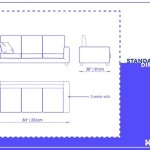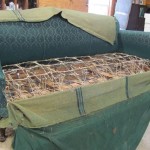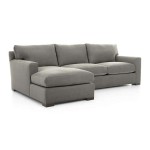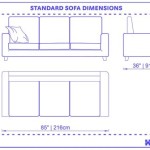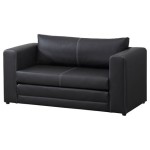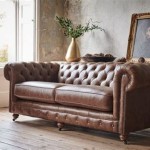Mid-Century Modern Sofa Cushions: A Detailed Guide
Mid-Century Modern (MCM) sofas are iconic pieces of furniture, recognized for their clean lines, organic shapes, and functional design. The cushions of these sofas are integral to both their aesthetic appeal and comfort. Understanding the characteristics, materials, and maintenance of MCM sofa cushions is essential for preserving the integrity and longevity of these valuable furnishings.
This article offers a comprehensive overview of MCM sofa cushions, covering aspects such as design features, common materials, methods of construction, considerations for replacement and restoration, and strategies for proper care.
Understanding the Design Elements of MCM Sofa Cushions
MCM sofa cushions are typically characterized by a minimalist approach to design. This includes a focus on geometric forms, often squares, rectangles, or elongated shapes, that complement the overall streamlined silhouette of the sofa. The absence of excessive ornamentation or detailing is a hallmark of the style.
Cushion profiles are generally low and relatively firm. Unlike more plush or overstuffed cushions, MCM designs prioritize a balanced level of support and visual lightness. This contributes to the airy and uncluttered aesthetic that defines the period. Edge detailing is often clean and precise, with minimal piping or welting. This reinforces the emphasis on simple, unadorned lines.
Color palettes commonly associated with MCM sofa cushions are varied, but tend to feature muted tones, earthy hues, or pops of vibrant color that align with the broader stylistic trends of the era. Fabrics often showcase geometric patterns, abstract designs, or solid colors rooted in nature. This allows the cushions to integrate seamlessly into a range of interior settings, while also contributing to the overall visual interest of the piece.
The arrangement of cushions on MCM sofas is also carefully considered. Common configurations include a single bench seat cushion, multiple individual cushions, or a combination of these arrangements. The aim is to achieve a balanced and visually appealing composition that enhances the sofa's overall form and function.
Materials Commonly Used in MCM Sofa Cushions
The materials used in the construction of MCM sofa cushions are selected for their durability, comfort, and aesthetic qualities. The choice of materials can significantly impact the sofa's overall feel and appearance.
Foam is the primary material used for filling. High-density foam is frequently preferred for its ability to provide firm support and maintain its shape over time. This type of foam resists compression and sagging, ensuring that the cushions retain their intended form and comfort level. Different densities of foam might be used in different parts of the cushion for optimized comfort. For example, a firmer foam might be used for the base, while a softer foam is employed for the top layer.
Dacron or polyester fiberfill is often used in conjunction with foam to provide a softer surface and enhance the cushion's overall comfort. This material is wrapped around the foam core to create a more plush and inviting feel. Furthermore, fiberfill helps to distribute weight evenly and prevents the foam from shifting or bunching.
Upholstery fabrics for MCM sofa cushions vary widely, but certain materials are particularly common. Wool is highly valued for its durability, natural resistance to stains and wear, and elegant texture. It’s a classic choice that fits well with the MCM aesthetic. Linen is another popular option, prized for its breathability, lightweight feel, and slightly textured appearance. It offers a more casual and relaxed look compared to wool. Vinyl, while sometimes associated with a more budget-friendly aesthetic, was also a common choice during the MCM era due to its durability, ease of cleaning, and water resistance. This was especially prevalent in homes with children or pets.
The selection of fabrics often involves careful consideration of texture, color, and pattern. The goal is to choose materials that complement the overall design of the sofa while also providing a comfortable and durable seating surface.
Construction Techniques and Considerations for Restoration
The construction of MCM sofa cushions involves a range of techniques designed to ensure durability, comfort, and aesthetic appeal. Understanding these construction methods is important for both maintaining existing cushions and undertaking restoration projects.
Cushion covers are typically constructed using techniques such as sewing, welting, and button tufting. Sewing involves joining fabric pieces together to create the cushion's outer shell. Welting, which involves adding a strip of fabric along the edges of the cushion, provides a tailored and defined appearance. Button tufting, a decorative technique that involves attaching buttons to the cushion's surface in a regular pattern, adds visual interest and can help to distribute the filling evenly.
Internal construction involves carefully securing the foam core and fiberfill within the cushion cover. This is often done using techniques such as stitching, gluing, or stapling. The aim is to ensure that the filling remains securely in place and does not shift or bunch over time. Proper internal construction is essential for maintaining the cushion's shape and comfort.
When restoring MCM sofa cushions, it is often necessary to replace worn or damaged materials. This may involve replacing the foam core, adding new fiberfill, or reupholstering the cushion cover. When selecting replacement materials, it is important to choose options that are consistent with the original design and construction of the sofa. For example, if the original cushion cover was made of wool, it is generally advisable to replace it with a similar type of wool fabric.
It's best practice to document the original construction techniques as you disassemble the cushion. Take pictures, note sewing patterns and where staples or glues are applied. This can serve as a roadmap when reassembling the cushions.
Carefully consider the condition of the existing frame and suspension system before restoring the cushions. A worn or damaged frame can undermine the effectiveness of even the most meticulously restored cushions. Ensure that the frame is structurally sound and that the suspension system is properly functioning before proceeding with the cushion restoration. This may involve repairing or replacing damaged frame components or re-tensioning or replacing the suspension system.
For complex restoration projects, consider consulting with a professional upholsterer or furniture restorer. These experts have the knowledge, skills, and tools necessary to restore MCM sofa cushions to their original condition. They can also provide guidance on selecting appropriate replacement materials and techniques.
Care and Maintenance of MCM Sofa Cushions
Proper care and maintenance of MCM sofa cushions are essential for preserving their appearance, comfort, and longevity. Regular cleaning, stain removal, and preventative measures can help to keep your cushions in good condition for years to come.
Regular vacuuming is essential for removing dust, dirt, and debris that can accumulate on the cushion surfaces. Use a brush attachment to gently vacuum the cushions on a regular basis. This will help to prevent the buildup of dirt and allergens that can damage the fabric and compromise the cushion's comfort.
Promptly address any spills or stains to prevent them from setting into the fabric. Use a clean, damp cloth to blot the spill, working from the outside in. Avoid rubbing the stain, as this can spread it and damage the fabric. For stubborn stains, consider using a mild detergent or a dedicated upholstery cleaner. Always test the cleaner on an inconspicuous area of the cushion first to ensure that it does not damage the fabric.
Rotate and flip cushions regularly to distribute wear evenly. This will help to prevent certain areas of the cushion from becoming overly compressed or worn over time. Rotating the cushions will also help to prevent fading caused by sunlight exposure. If possible, avoid placing your sofa in direct sunlight, as this can cause the fabric to fade and deteriorate.
Consider using protective covers or throws to shield your cushions from spills, stains, and sunlight. These can be easily removed and cleaned, providing an extra layer of protection for your cushions. Choose covers or throws that complement the style of your sofa and décor of your home.
Professional cleaning can be beneficial for maintaining the cleanliness and appearance of your cushions. Consider having your cushions professionally cleaned every one to two years, or more frequently if they are heavily used or exposed to spills or stains. Professional cleaners have the knowledge and equipment necessary to safely and effectively clean your cushions without damaging the fabric.
Regularly inspect your cushions for signs of wear or damage. Look for tears, holes, loose seams, or worn areas. Address any problems promptly to prevent them from worsening. Minor repairs, such as sewing a loose seam, can often be done yourself. However, more extensive repairs may require the services of a professional upholsterer.

By Style Mid Century Modern

Buy Bella Mid Century Modern Throw Cushion Set At 20 Retail Staunton And Henry

81 Elegant Mid Century Modern Sofas For Your Interior Digsdigs

Lifestyle Solutions Lorelei Mid Century Modern Cushion Back Upholstered Sofa Olive Fabric

Groton Mid Century 3 Seater Vintage Leather Sofa With Solid Wood Legs Brown So Home La Redoute

7 Best Mid Century Modern Sofas In 2024 According To Experts

Maxime Light Gray Mid Century Modern Sofa La Mattress

Margo I Mid Century Modern On Back Apartment Fabric Sofa Club Furniture

Mid Century Sofa Cushions Or Parade Made Of Brocade Velvet And In Green Brown Tones 1960s

Streamdale Furniture Mid Century Modern 3 Seater Sofa With Tufted Backrest And Comfy Cushion Macy S

